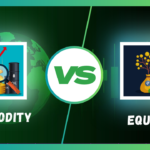If we look at the money-making strategies in the financial market, there are plenty. Ranging from equities, forex trading, commodity trading, bonds, and many more. Selection is widely available. However, is there a need to invest or even trade? Some would say looking at the economic indicators like the rate of inflation, is necessary. Shying away from taking a possible opportunity, might be harmful to wealth creation.
The stock market is a device to transfer money from the impatient to the patient – Warren Buffet
Leading to plenty of opportunities, the question arises, what is the best way to earn money in the stock market? The following blog tilts toward the idea of such questions.
A-Basics Guide to the Stock Market
The stock market is a marketplace where securities are exchanged for earning profits. Securities are assets that have value embedded. Some are less valuable, while others are more valuable. There is a whole regulation process carried out by the U.S. SEC (U.S. Securities and Exchange Commission).
The stock market has a lot of participants. The governments, banks, corporations or hedge funds, and individuals are the market participants.
There are a variety of stocks or shares available. Different types of stocks are:
Common Stock
Common stock is also known as ordinary shares. It is a unit of a business that is publicly available. Here, demand and supply fluctuate the price. The common stockholders carry a right to vote in internal matters, the right to claim dividends, and several other added benefits. Shareholders carry the most risk, as the obligation to pay them is after creditors, and preference stockholders.
Preferred Stock
Preferred stock represents the ownership of a company. These are also publicly available. Preference stockholders have a tall claim over common stockholders in a business, hence a preference stock. However, their rate of return is fixed in contrast to common stocks. They typically don’t carry voting rights as well as the claim to dividends. They offer less risk than common stocks.
Long-Term Investing Strategies
Looking at the long-term investing strategies, there should be substantial reasons to select the tried and tested method. A lot of equity market foundation is based upon long-term investing, helping investors to stay in the game for long. Various long-term investing strategies are:
Growth Investing
Investing in growing companies is growth investing. Finding opportunities in small or medium-sized companies that carry a mass potential to achieve better growth than their industry peers. Because of the better growth prospects, the yield of return could also rise.
Dollar-Cost Averaging
Dollar-cost averaging is a technique to average your price to invest in equity. It involves investing in small quantities rather than in bulk. This brings the share price to a much lower level, hence increasing the profit-earning capacity. It also reduces the risk of buying equities at higher prices.
Value Investing
Value investing is a technique where investors try to uncover undervalued stocks. In a pile of overvalued stocks, value investing is used as a filter to find value. It can produce an extremely high rate of returns. Although the technique is like finding a needle in a haystack. This investment approach is only mastered by a few investors. For successful value investing, buy and hold is a key strategy.
Short-Term Trading Strategies
Trading in the share market comes in all shapes and sizes. Finding the right strategy to trade is crucial, especially in the short term. Still, proper research and analysis is required. The following are the short-term trading strategies:
Day Trading
Allowing traders to make money on a daily basis is what day trading technique is. Not only profits, losses are also a part of trading. In this strategy, all open trades are squared off (sold) within a day. Hence, accumulating whatever loss or profit is gained. Day trading is mostly done on charts. Charts include candlesticks and patterns.
Scalping
Scalping is a method where traders earn small profits. Providing a faster turnaround time to execute trades. Scalping allows the trader to open multiple trades in one go. A shorter turnaround time leads to more trades, hence profit earning ability surges. It follows the concept of market timing.
Trend Following
There are a number of trading strategies in the share market. The most common, still the hardest one is the trend following. It allows the trader to follow a predetermined trail of trends. Hence, it’s like jumping on the bandwagon. Buying the stock when the trend is rising and selling when the trend is about to go bust.
These are some of the active ways to participate in the stock market. However, there are passive ways as well.
Passive Investing Strategies
Passive investing strategies are methods that allow the investors to passively participate in the share market. If investors are facing time constraints, then these strategies could prove to be vital. Passive investing strategies are:
Index Fund Investing
An index is a stock exchange on which equities trade. Indexes represent an economy. As all stocks are part of the index, buying them results in average-to-market returns. Index fund investing allows investors to attain a portfolio of shares. They provide protection from unusual market trends.
Exchange-Traded Fund (ETF) Investing
An ETF or exchange-traded fund is an amalgamation of securities. Their prices fluctuate all day, just like stocks. It combines bonds, stocks or commodities. The ETF offers cheaper fees than other funds. The only greater risk in ETFs is illiquidity.
Factors to Consider When Choosing a Strategy
There are several factors that could affect the earning capacity in the equity market. A variety of internal and external factors could come into play. While investing consider these factors before investing or trading:
Risk-Reward Ratio
Understanding the risk-reward ratio is crucial to stock markets. Where the amount of risk is massive and reward is not enough and it doesn’t make sense, don’t enter. However, when the risk is less and the reward is plentiful, try entering. It makes all the strategies worthwhile. However, proceed with caution, as risks are always there.
Economic Outlook
All the markets are influenced by economic turbulence. Keeping tabs on the economic outlook can certainly help. Changes in the economy present opportunities. Chasing even a single one can reap multifold returns. Hence, try to check the economic outlook.
Liquidity
Liquidity is an important parameter. Because for traders, having enough liquidity will allow them to trade efficiently. Especially, during bearish trends, liquidity is crunched so try using stop-loss orders. Stop-loss orders will save your portfolio from falling insignificantly.
Having a broker who cares for trader education is crucial in distressed times.
MarketTargets: Stock Trading Platform
With 13+ years of experience in stock trading, Market Targets is a key platform. They have stood the test of time even in turmoil. Market Targets have secured traders’ confidence through reliability, access to global accessibility, powerful platforms, and exceptional support. Catering to clients in a professional manner is the need of the hour, hence choose Market Targets.
You can also open your account on Market Targets by following these easy steps:
- Register your account.
- Fund your account.
- Start trading.
Conclusion
Understanding all the different ways gives us some ideas. The variety of strategies in the long term and short term add more value from dollar-cost averaging to growth investing. And from day trading to scalping, the options are endless. But these are much more active forms of strategies to participate in the stock market. There are others that are passive as well, allowing room for everyone. Using these strategies can potentially unlock the wealth creation pot.
However, the best way to earn money in the stock markets depends on time spent. How? If investors have less time at hand, then they can use passive investing strategies like ETFs and index funds investing. Meanwhile, investors with more time must try long-term investing strategies like growth investing and dollar-cost averaging. Although following the path of diversification can reduce risk. Traders should keep themselves busy with technical analysis.
Frequently Ask Questions (FAQ’s)
Q) What is a stock market and how risky is it?
And) Stock market is known as the market where stocks or shares are bought and sold at prices, derived from supply and demand. The share market is definitely a risky place. Because it can fall from 50% to 80%, and even more at bearish market cycles.
Q) What do you mean by fundamental analysis?
Ans) Fundamental analysis is the study of understanding company performance, company financials, microeconomic and macroeconomic factors.
Q) What is MarketTargets?
Ans) Market Targets is a platform that allows the trading of stocks, forex, commodities, and cryptocurrency. It has some of the best-in-class trading platforms that allow traders to get real-time price updates.
Q) What is active portfolio management?
Ans) In an active portfolio management strategy, investors take turns to beat a specific index like the S&P 500. Their main aim is to make more than market returns.
Q) Do preferred stocks have any rights?
Ans) Preferred stocks usually don’t carry any rights like voting, the right to dividend claim, etc.
Q) Who gets paid the last after the winding up of the company?
Ans) Common stockholders carry the most risk and, hence are paid the last after paying the obligation of the business and preferred shareholders.
Q) How is dividend investing beneficial?
Ans) Dividend investing allows investors to earn a constant rate of return through dividends. There are companies who pay a high dividend yield.



